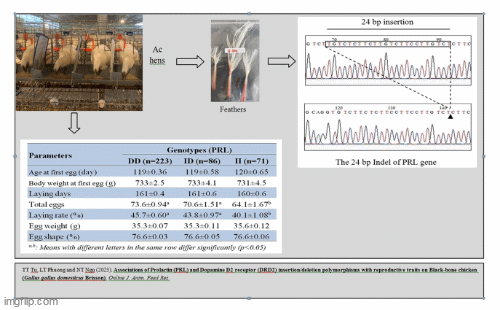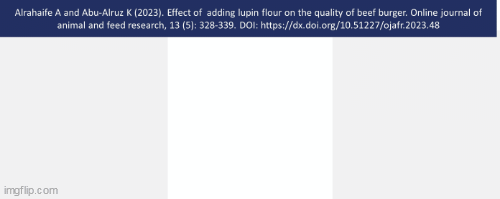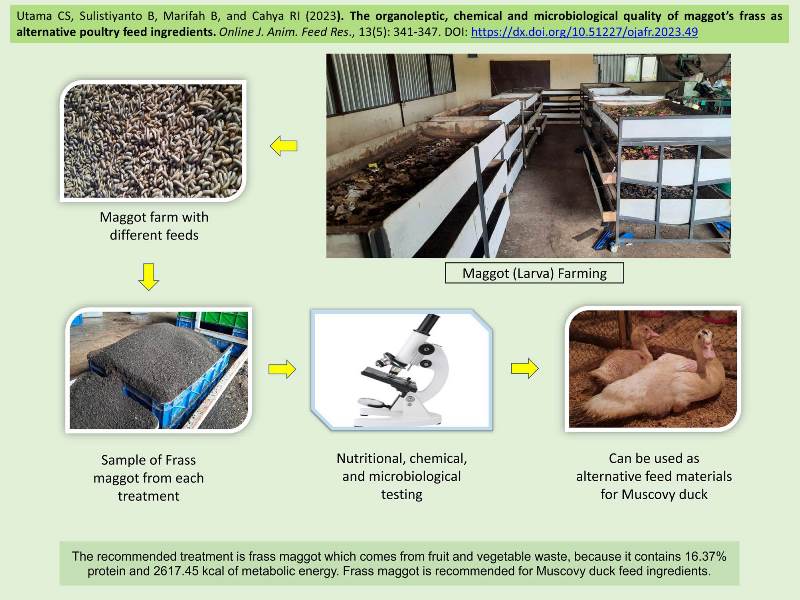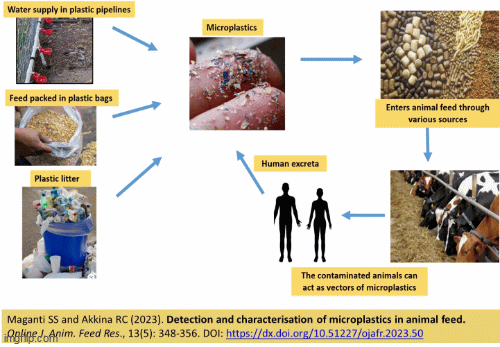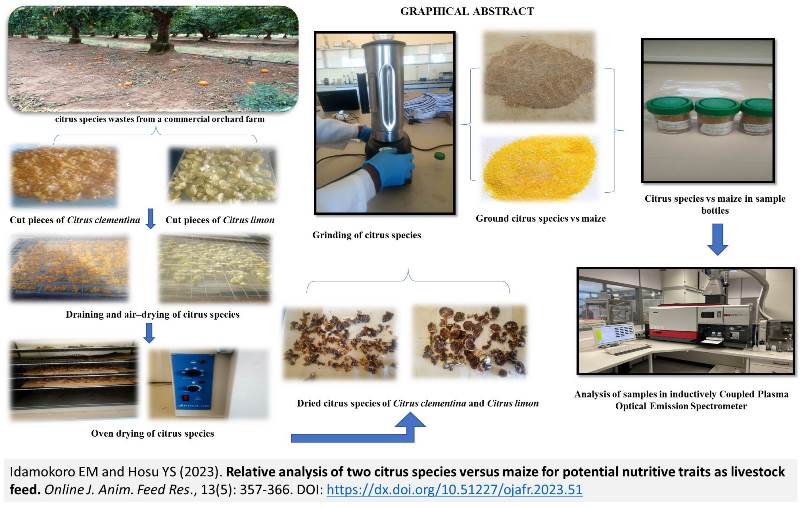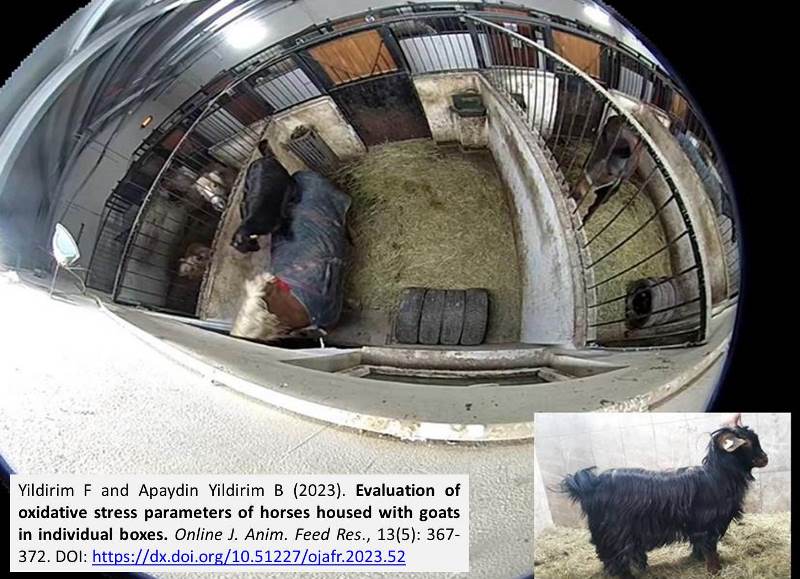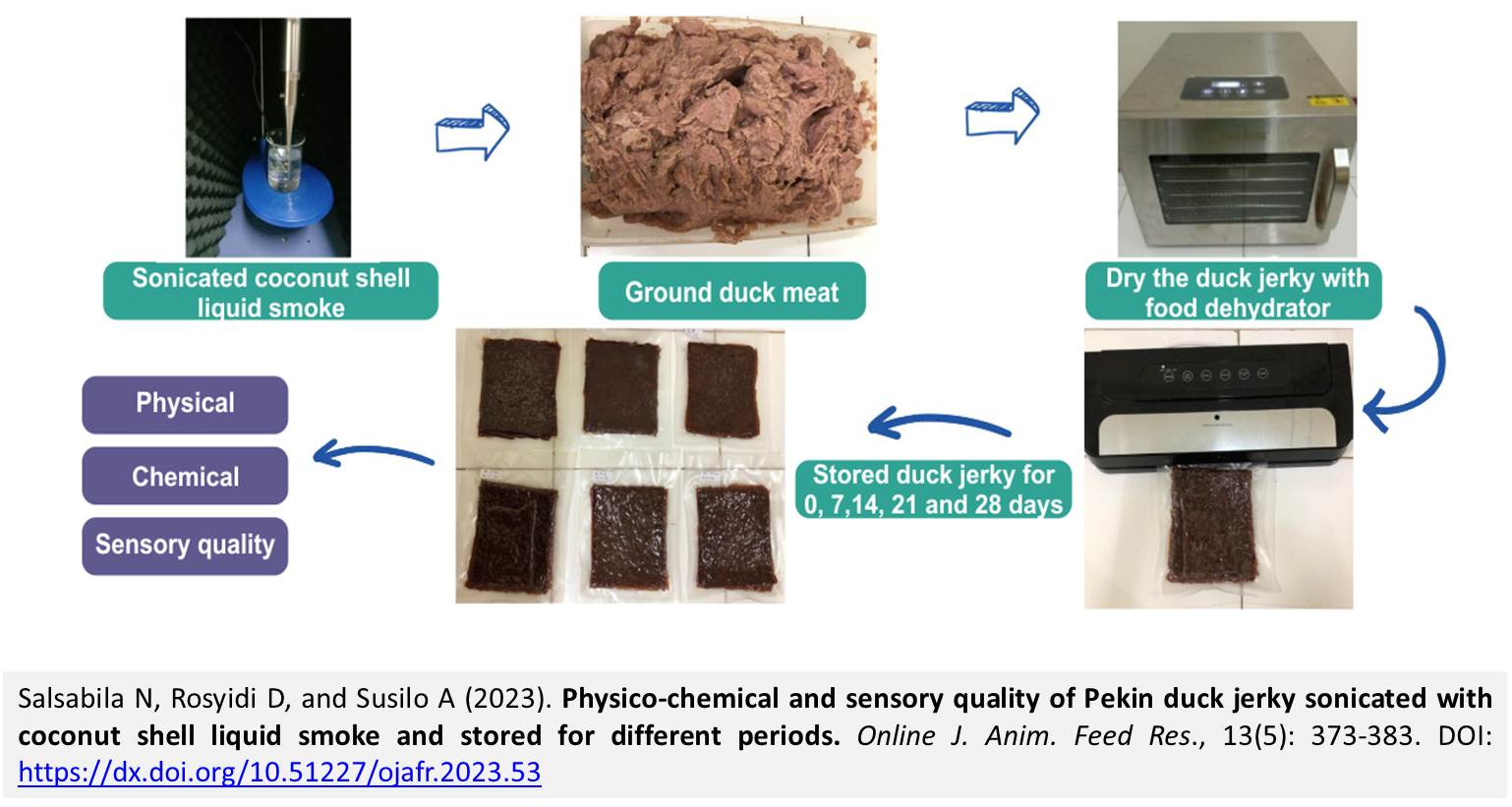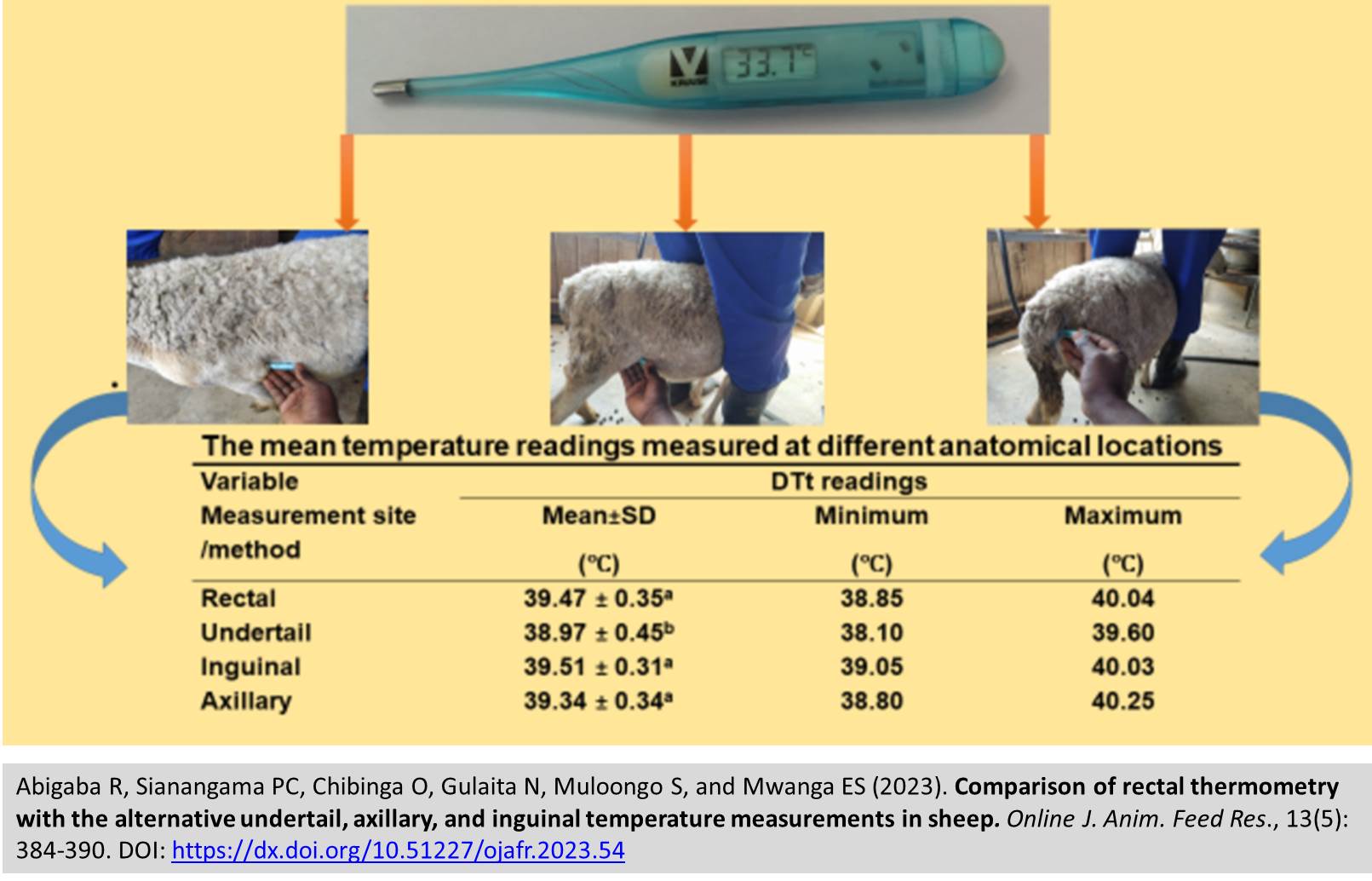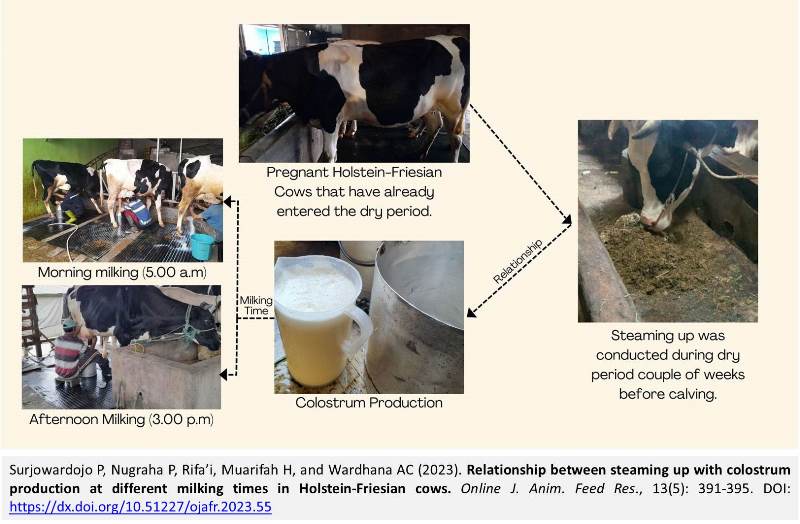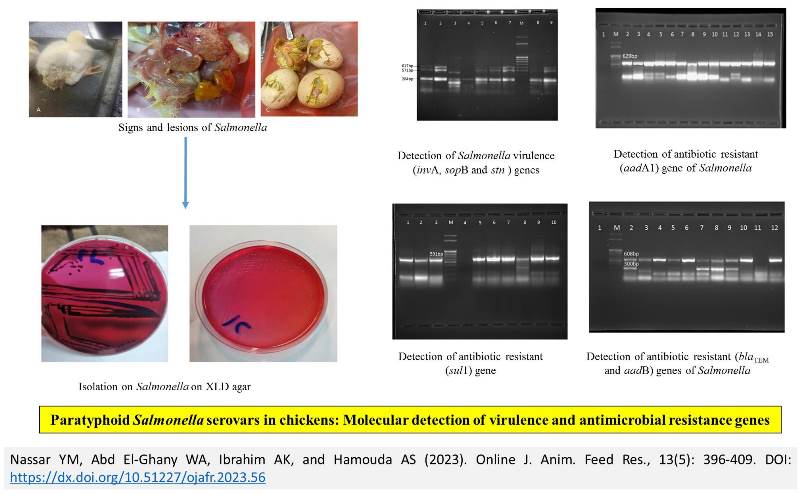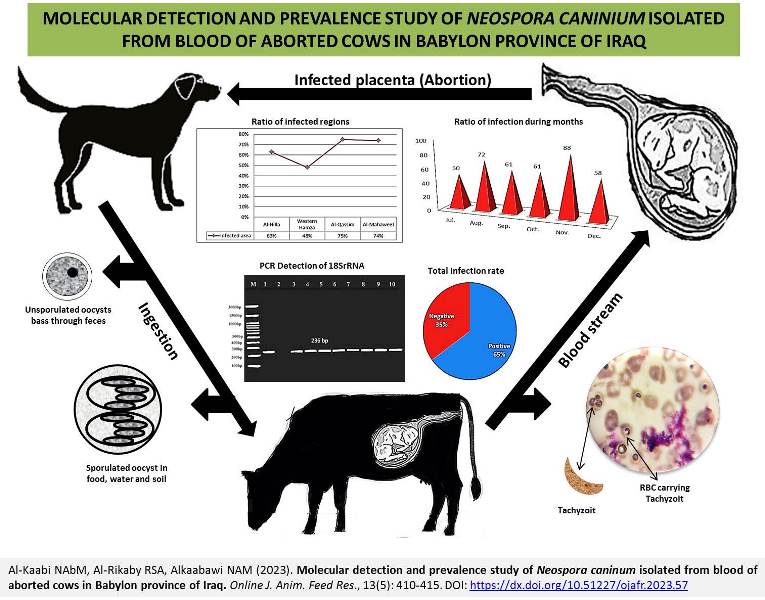Previous issue | Next issue | Archive
![]() Volume 13 (5); September 30, 2023 [Booklet]
Volume 13 (5); September 30, 2023 [Booklet]
Associations of polymorphisms in prolactin and dopamine receptor D2 genes with reproductive traits on Silkie chicken
Tu TT, Phuong LT, and Ngu NT.
Online J. Anim. Feed Res., 13(5): 321-327, 2023; pii: S222877012300047-13
DOI: https://dx.doi.org/10.51227/ojafr.2023.47
Abstract: The Silkie chicken (Gallus gallus domesticus Brisson) is one of domestic chicken breeds with commercial rearing and breeding potentials for egg production. Prolactin (PRL) and dopamine D2 receptor (DRD2) are potential genes associated with reproductive traits in chickens. This study was conducted to analyze the association of PRL and DRD2 insertion/deletion (Indel) polymorphisms with chicken reproductive traits in Silkie chickens. A total of 380 hens from 16-40 weeks of age were used, with each one being placed in a separate cage. DNA isolation was performed using feather samples, and genotypes were detected using the Indel technique. Two polymorphisms consisting of 24 base pair (bp) Indel in the promoter region of the PRL gene and 22 bp Indel in the promoter region of the DRD2 gene were identified. At both sites, the Indel polymorphisms did not follow the Hardy-Weinberg equilibrium. In addition, with the exception of total eggs over 23 weeks of laying in the PRL gene, the analysis revealed no association between these polymorphic loci and any traits collected. In conclusion, birds with the DD genotype produced the maximum egg yield (73.6 eggs/hen), whereas those with the II genotype produced approximately 9 fewer eggs (64.1 eggs/hen), resulting in laying rates of 45.7% and 40.1%, respectively. For enhancing the egg-laying capacity of Silkie chickens via selective breeding, opting for DD birds with DD genotype of PRL Indel is highly recommended.
Keywords: Egg production, Indel technique, Polymorphism, Reproductive traits, Silkie chicken.
[Full text-PDF] [Scopus] [ePub] [Export from ePrints]
Effects of incorporation of lupin flour on the quality attributes of beef burger
Alrahaife AJ, and Abu-Alruz Kh.
Online J. Anim. Feed Res., 13(5): 328-339, 2023; pii: S222877012300048-13
DOI: https://dx.doi.org/10.51227/ojafr.2023.48
Abstract: Lupin flour is known as an alternative high-ptlant protein for meat products due to its nutritional, health, and functional properties. A factorial experiment was performed to investigate the effect of lupin seed flour treatment (without, steaming, and roasting), meat substitution level with lupin seed flour (0, 5, 10, and 15%), and the interaction between them on the quality attributes of cooked beef burger by measuring CIELAB color, texture profile analysis (TPA), chemical composition (before and after cooking), and cooking properties (cooking loss, fat and moisture retention, and shrinkage). Based on the results of the factorial experiment, a completely randomized design was used to evaluate the sensory attributes of selected treatments. The different substitution levels mainly affected CIELAB color values, chemical composition, and cooking properties. On the other hand, the interaction effect between substitution level and treatment affected TPA. Considering all results, steaming treatment and a substitution level of 10% were selected as the best treatment to produce beef burgers. In comparison to the control burger, the developed burger had higher values of L* (increased by 21.26%), b* (increased by 32.94%), and moisture retention (increased by 37.85%); lower values of fat (decreased by 16.11%), protein (decreased by 6.37%), cooking loss (decreased by 43.22%), shrinkage (decreased 19.69%), and moisture content (decreased by 2.64%); and nonsignificantly different values with other tests performed. This study demonstrated that the incorporation of lupin flour in beef burgers could have the potential to substitute meat, create an alternative high-plant protein burger, and expand the application of lupin flour in the food industry.
Keywords: Beef, Chemical composition, Cooking loss, Physical properties, Sensory properties, Texture.
[Full text-PDF] [Scopus] [ePub] [Export from ePrints]
The organoleptic, chemical and microbiological quality of maggot’s frass as alternative poultry feed ingredients
Utama CS, Sulistiyanto B, Marifah B, and Cahya RI.
Online J. Anim. Feed Res., 13(5): 340-347, 2023; pii: S222877012300049-13
DOI: https://dx.doi.org/10.51227/ojafr.2023.49
Abstract: Maggot’s frass is waste from cultivating maggots (insect larvae) which consists of media from maggot cultivation mixed with feces, skin and dead body of the maggots. The aim of the study was to examine the organoleptic quality, chemistry, worm eggs, lead (Pb) as heavy metal and microbiological profile of maggot’s frass as an alternative ingredient of poultry feed. A completely randomized design (CRD) with 3 treatments (T1: frass media for household waste, T2: frass media for tofu dregs, and T3: frass media for vegetable and fruit waste) and 7 replications was used. The results showed that there was no effect of different types of media treatment on the organoleptic quality, chemistry and microbiological profile of maggot’s frass. The results of chemical analysis of maggot’s frass revealed moisture of 26.39 - 46.26%, crude protein of 10.92 - 16.37%, worm eggs in the dregs media tofu (16 EPG), vegetable and fruit waste (32 EPG), total bacteria of 1.91-4.95 x 108cfu/g, and no any Escherichia coli and Salmonella isolates. Maggot’s frass which comes from fruit and vegetable waste was recommended. Therefore, maggot feed using fruit and vegetable waste treatment is recommended because of its high crude protein and metabolic energy and also without any E.coli and Salmonella contamination.
Keywords: Black Soldier fly; Feed; Maggot’s frass; Larva; Waste.
[Full text-PDF] [Scopus] [ePub] [Export from ePrints]
Detection and characterisation of microplastics in animal feed
Maganti SS and Akkina RC.
Online J. Anim. Feed Res., 13(5): 348-356, 2023; pii: S222877012300050-13
DOI: https://dx.doi.org/10.51227/ojafr.2023.50
Abstract: Microplastics (MPs) the products of plastic breakdown, are entering the environment as a result of plastic abuse, which are of size less than 5mm. Due to their ubiquitous nature, MPs have become a significant environmental concern. One alarming area of MPs contamination is their potential presence in the feed of edible animal species. Growing research suggests that MPs can enter food products and subsequently move to various trophic levels of food chains. Hence, assessing the threat of MPs contamination in animal feed is important for food security and human health. In this investigation, 36 livestock and poultry feed samples were collected from 12 different farms, MPs were detected using Fourier Transform Infrared Spectroscopy (FTIR) and Differential Scanning Calorimeter (DSC). The Nano particle analyser was used to determine the size distribution, and Pyrolysis-GC/MS was used to quantify MPs. According to the findings, all the feed samples contained a significant amount of Polyethylene terephthalate (PET), Polypropylene (PP), and Polyvinyl chloride (PVC) and the particle size ranged from 2.02 to 10.7 µm. Present study has given detailed information on the size distribution of MPs in animal feed, which is thought to enable them to pass through membrane barriers. From the findings it is evident that there are high chances of MPs entering animal feed due to the continuous contact of the feed with plastic-based materials. These MPs can accumulate in the tissues of animals and potentially be transferred to humans through the consumption of meat, milk, and other animal-derived products. Subsequently these MPs can finally bio-accumulate in humans and cause serious health issues.
Keywords: Feedstuff, Membrane barriers, Nanoparticles, Pyrolysis-GC/MS, Size distribution.
[Full text-PDF] [Scopus] [ePub] [Export from ePrints]
Relative analysis of two citrus species versus maize for potential nutritive traits as livestock feed
Idamokoro EM and Hosu YS.
Online J. Anim. Feed Res., 13(5): 357-366, 2023; pii: S222877012300051-13
DOI: https://dx.doi.org/10.51227/ojafr.2023.51
Abstract: The present study seek to assess the nutritional qualities and the mineral composition of citrus fruits (pulps + peels) of two different species (Citrus clementina and Citrus limon), while comparing its nutritive perspective with Zea mays L (yellow maize) commonly used as livestock feed. Proximate evaluation was done via the method of the association of official analytical chemists (AOAC). Elemental components of citrus species were measured by means of a standard spectrometer. The proximate evaluation of the sample indicated that Citrus limon fruit contained comparable amounts of protein, fibre and lipid, but significantly higher ash contents than yellow maize. While the Citrus clementina was higher in protein and ash content, but comparable moisture content to Zea mays L. Meanwhile, minerals including Ca, Mg, K, Na, Cu, Mn and Fe were significantly higher in the two citrus species than in Zea mays L. Therefore the manuscript revealed that the Citrus clementina and Citrus limon species possess the potentials to be utilized as livestock feed ingredients.
Keywords: Citrus fruit, Elemental composition, Maize, Nutritional quality, Proximate analysis.
[Full text-PDF] [Scopus] [ePub] [Export from ePrints]
Evaluation of oxidative stress parameters of horses housed with goats in individual boxes
Yildirim F and Apaydin Yildirim B.
Online J. Anim. Feed Res., 13(5): 367-372, 2023; pii: S222877012300052-13
DOI: https://dx.doi.org/10.51227/ojafr.2023.52
Abstract: Horses are animals that are affected very quickly by the warnings coming from the environment. In this study, it was aimed to evaluate oxidative stress parameters of horses obtained from saliva analysis related to animal welfare as a result of keeping horses together with goats. While the research was being prepared, three groups were developed based on the time spent sheltering goats and horses. The horses were housed alone in the first and last 15-day groups, and along with the goats in the second 15-day group. In these stages, the levels of malondialdehyde (MDA), catalase (CAT), glutathione peroxidase (GPx), superoxide dismutase (SOD) activities and ischemia-modified albumin (IMA) level in saliva were examined. Results showed that MDA and IMA levels decreased, but CAT, GPx, and SOD activities increased. It was concluded that goats had a positive effect on horses according to the oxidative stress parameters examined in terms of animal welfare. However, there is still a need for research that will house horses with various animals in acceptable animal welfare circumstances, analyse their stress metrics, and maintain a high level of welfare.
Keywords: Animal welfare, Equus caballus, Oxidative stress, Single stall housing, horse, goat.
[Full text-PDF] [Scopus] [ePub] [Export from ePrints]
Physico-chemical and sensory quality of Pekin duck jerky sonicated with coconut shell liquid smoke and stored for different periods
Salsabila N, Rosyidi D, and Susilo A.
Online J. Anim. Feed Res., 13(5): 373-383, 2023; pii: S222877012300053-13
DOI: https://dx.doi.org/10.51227/ojafr.2023.53
Abstract: This study aimed to determine the effect of adding sonicated coconut shell liquid smoke to pekin duck jerky with different storage times at room temperature and vacuum packed. Ground duck jerky is made from Pekin duck meat (Anas platyrhynchos domesticus) soaked in coconut shell liquid smoke (CSLS) which has been sonicated for 20 minutes and seasoned with spices such as garlic, galangal, coriander, tamarind, salt, and coconut sugar. A laboratory experiment was done using a completely randomized design (CRD) consisting of 5 treatments (control: 0 day storage period, T1: 7 days, T2: 14 days, T3: 21 days, and T4: 28 days) and 4 replications. The results showed that the addition of sonicated CSLS with differences in the shelf life of pekin ground duck jerky had a significant effect (P<0.01) on pH, texture, color L, a*, b*, Aw, water content, fat, carbohydrates by difference, thiobarbituric acid (TBA), and iodine number. Had a significant effect (P<0.05) on ash content, and had no significant effect on Water Holding Capacity (WHC), protein content, and organoleptic quality. It was concluded that storing ground duck jerky for 14 days at room temperature and vacuum packed did not show any damage to pH, water activity, water content, fat, protein, TBA and iodine number, and did not occur rancidity.
Keywords: Liquid smoke, Jerky, Pekin duck, Shelf life, Sonication.
[Full text-PDF] [Scopus] [ePub] [Export from ePrints]
Comparison of rectal thermometry with the alternative undertail, axillary, and inguinal temperature measurements in sheep
Abigaba R, Sianangama PC, Chibinga O, Gulaita N, Muloongo S, and Mwanga ES.
Online J. Anim. Feed Res., 13(5): 384-390, 2023; pii: S222877012300054-13
DOI: https://dx.doi.org/10.51227/ojafr.2023.54
Abstract: This study was conducted to ascertain the suitability of alternative locations for temperature measurement, with reference to rectal thermometry in sheep, using a digital thermometer (DT). The study employed a single-factor multilevel design, considering anatomical location (site) as the main factor. This anatomical location factor had four conditions, including rectal (rectalDTt), undertail (undertailDTt), inguinal (inguinalDTt), and axillary (axillaryDTt) locations. A total of 16 sheep were recruited for the study, and each treatment had eight replicates. The data obtained were descriptively analyzed using means and standard deviations, while inferential statistics included analysis of variance (ANOVA), Pearson’s correlation, Tukey’s test, t-test, and Bland-Altman plot. The mean inguinalDTt was the highest (39.51 ± 0.31℃), while the lowest was the mean undertailDTt (38.97±0.45). The effect of anatomical location on temperature readings was statistically significant. The difference between mean rectalDTt and inguinalDTt, or axillaryDTt was not significant. The rectalDTt measurements were significantly correlated with those of each treatment. Equivalence analysis revealed a non-significant bias between the rectalDTt and inguinalDTt pair. The Bland-Altman plot showed a good level of correlation and considerable agreement between rectalDTt and inguinalDTt measurements. In conclusion, temperature measurement at the inguinal location results in readings that are similar to those of rectal thermometry and thus may be of clinical importance in the future, particularly with digital thermometer application in sheep.
Keywords: Anatomical location, Body temperature, Digital thermometer, Sheep, Rectal thermometry.
[Full text-PDF] [Scopus] [ePub] [Export from ePrints]
Relationship between steaming up with colostrum production at different milking times in Holstein-Friesian cows
Surjowardojo P, Nugraha P, Rifa’i, Muarifah H, and Wardhana AC.
Online J. Anim. Feed Res., 13(5): 391-395, 2023; pii: S222877012300055-13
DOI: https://dx.doi.org/10.51227/ojafr.2023.55
Abstract: Aims of study was to determine the relationship between steaming up with colostrum production at different milking times. The animals used in this research were 36 pregnant Holstein-Friesian (HF) cows. The method used in this research was a case study. Samples were determined with purposive sampling. The selected animal was divided into two groups, T1 (control) and T2 (steaming up). The steaming up was done two weeks prior to calving. The total average of colostrum production from HF cows that were in T2 group was 11.96±2.40 liter/cow/day, while the mean value of colostrum production from HF cows that were in T1 group was 8.05±1.80 liter/cow/day. The average colostrum production that was collected at morning milking from cows in T2 group was 6.38±1.36 liter/cow/day and at afternoon milking was 5.58±1.11 liter/cow/day, significantly higher than T1 group which was 4.22±0.92 liter/cow/day at morning milking and 3.83±0.90 liter/cow/day. The result of the regression equation on morning milking is Y = 2.059 + 2.159x. This means that steaming up treatment can increase colostrum production by as much as 2.159 liters at morning milking. While the result of the regression equation on afternoon milking is Y = 1.753 + 2.078x. This means steaming up treatment can escalate the colostrum production as much as 2.078 at afternoon milking. That equation is used as the basis for estimating the relationship between steaming up with colostrum production at both milking times, with a correlation coefficient (r) between steaming up and colostrum quantity at morning milking is 0.692, which means the relationship is in the strong category. Meanwhile, the relationship between steaming up and colostrum yield at afternoon milking is 0.666, which means the relationship is also in the strong category. It was concluded that steaming up had a very significant effect at both milking times in Holstein-Friesian cows.
Keywords: Calving, Colostrum production, Holstein-Friesian Cows, Milking time, Steaming up.
[Full text-PDF] [Scopus] [ePub] [Export from ePrints]
Paratyphoid Salmonella serovars in chickens: molecular detection of virulence and antimicrobial resistance genes
Nassar YM, Abd El-Ghany WA, Ibrahim AK, and Hamouda AS.
Online J. Anim. Feed Res., 13(5): 396-409, 2023; pii: S222877012300056-13
DOI: https://dx.doi.org/10.51227/ojafr.2023.56
Abstract: Paratyphoid salmonellosis is a serious disease threatens the poultry industry worldwide, besides its public health hazard. The aims of this study were characterization of paratyphoid Salmonella spp. in chicken flocks of some Egyptian governorates, demonstration of the antimicrobial susceptibility of the isolated Salmonella spp., and detection of some virulence genes and antibiotic resistance genes using recent molecular techniques. A total of 238 organ samples were collected from 52 broiler, layer, and breeder chicken flocks, representing 9 Egyptian governorates. Conventional characterization of Salmonella isolates revealed a total isolation rate of 56.3% (134/238). Moreover, the isolation rates of Salmonella spp. were (49/79; 62%), (47/81; 58%), (10/18; 55.5%), (9/20; 45%), (2/6; 33.3%), (2/3; 66.7%), and (15/82; 53.6%) from liver, yolk sac, heart, spleen, caecum, ovary, and dead-in-shell embryos, respectively. A total of 32/238 (13.44%) isolates of Salmonella were found. Serological identification revealed presence of S. enteritidis (21.9%), S. kentucky (15.6%), S. typhimurium (12.5%), S. molade (12.5%), S. takoradi (9.4%), S. wingrove (6.3%), S. infantis (6.3%), S. tsevie (6.3), S. shangani (3.1%), S. bargny (3.1%), and S. papuana (3.1%). All Salmonella strains (32/32; 100%) were resistant to streptomycin, while almost all of them (31/32; 96.9%) were susceptible to meropenem. The amplification of 16S rRNA gene of Salmonella isolates using uniplex polymerase chain reaction (PCR) generated a specific Salmonella product of approximate 550 base pair. The multiplex PCR revealed presence of invA (100%), stn (65.6%), and sopB (40.6 %) virulence-associated genes as well as aadA1 (100%), blaTEM (59.4%), aadB (18.75%), and sul1 (28.1%) antibiotic resistance genes. In conclusion, virulent paratyphoid Salmonella spp. are circulating in the Egyptian flocks, causing economic loses. Additionally, they became resistant to the most commonly used field antibiotics. Therefore, regular molecular surveillance studies on the circulating Salmonella spp. and their resistance to the used antibiotics are of significant importance.
Keywords: Antibiotic resistance genes, Chicken, Paratyphoid Salmonella, PCR, Serology, Virulence
[Full text-PDF] [Scopus] [ePub] [Export from ePrints]
Molecular detection and prevalence study of Neospora caninum isolated from blood of aborted cows in Babylon province of Iraq
Al-Kaabi NAbM, Al-Rikaby RSA, Alkaabawi NAM.
Online J. Anim. Feed Res., 13(5): 410-415, 2023; pii: S222877012300057-13
DOI: https://dx.doi.org/10.51227/ojafr.2023.57
Abstract: Neosporosis is internationally documented as one of the most popular diseases in cattle that cause economic losses due to high levels of abortion cases. Although Neospora caninum has been recently classified as a new species, it is still sharing many features with Toxoplasma gondii. This study aimed to detect and Imaging N. caninum in the blood of aborted cows, and prevalence study of N. caninum infection based on age, region and month. Blood samples from 106 aborted cows were collected using the appropriate method. First, these samples were examined microscopically via blood smears using Giemsa dye to diagnose the N. caninum within RBC. A qPCR technique was carried out to detect accurately 18S rRNA gene accurately. The results revealed that 65% of total aborted cases were positive for 18S rRNA detection of N.caninum, although this parasite was found microscopically in 15% of blood smear samples. According to PCR results, the prevalence study showed that the highest rate of infection was signed in the Al-Qassim district (75%) followed by the Al-Mahaweel district (74%) and decreased in Western Hamza district (48%). According to study months, November recorded the peak of infection (88%), then August (71%), whereas July recorded the lowest percentage (50%). The statistical analysis revealed there was no significant difference between the subjected regions and study months based on (P<0.05). On the other hand, it was found that cows less than 3 years old were more susceptible to infection than those over 3 years old. the results revealed that 71% of infected cows were less than 3 years old, while 29% were at age over 3 years old with a significant difference (P<0.005). In conclusion, N. caninum can be detected through blood within RBC. Age and regional factors in cows play an important role in resisting infection with this pathogen.
Keywords: Cow, Neosporosis, N. caninum, Prevalence, 18S rRNA
[Full text-PDF] [Scopus] [ePub] [Export from ePrints]
Previous issue | Next issue | Archive
This work is licensed under a Creative Commons Attribution 4.0 International License (CC BY 4.0).![]()
| < Prev | Next > |
|---|

